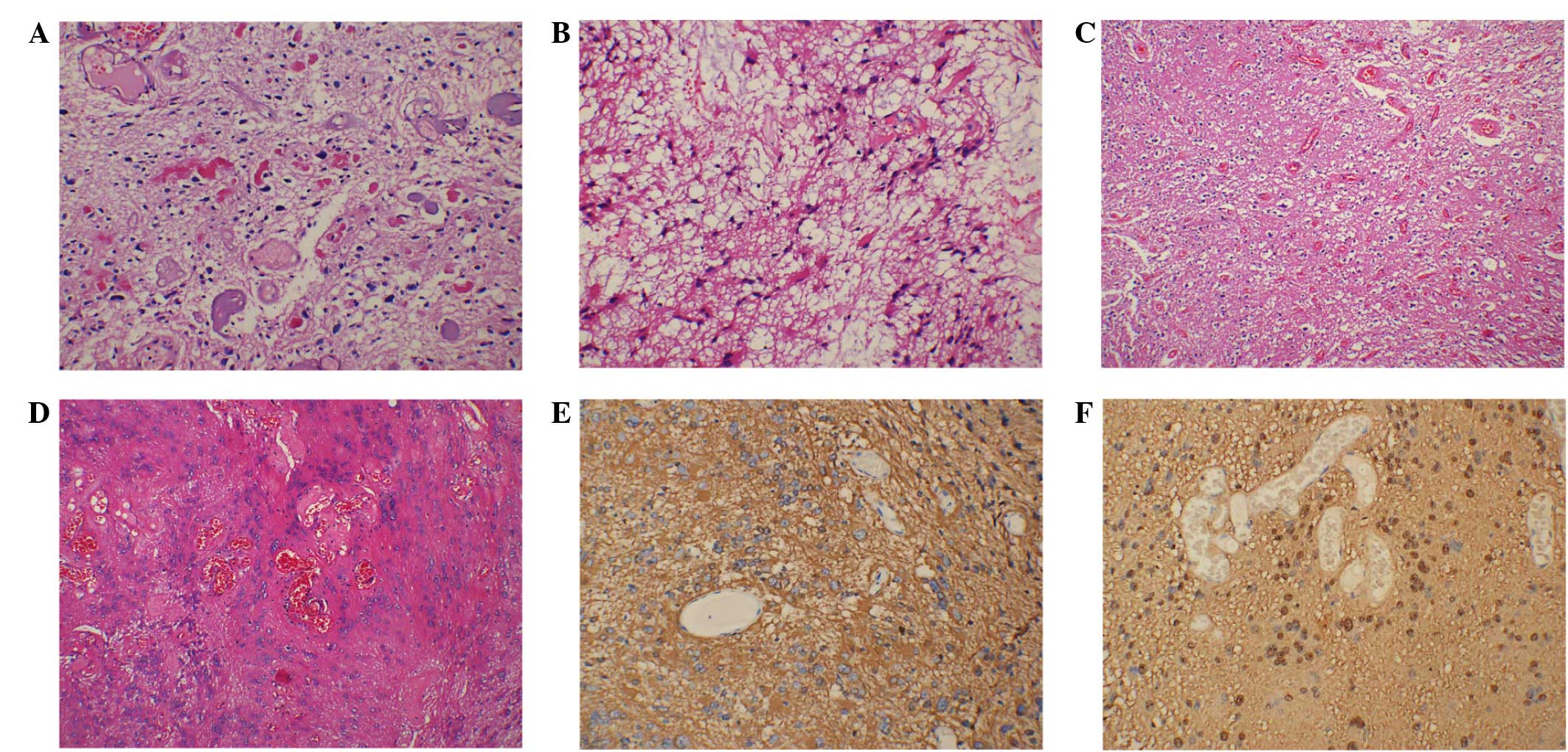Adult cervicomedullary pilocytic astrocytoma: A case report
- Authors:
- Yaodong Zhao
- Lijin Feng
- Qing Wei
- Liang Gao
View Affiliations
Affiliations: Department of Neurosurgery, Shanghai 10th People's Hospital, Tongji University, School of Medicine, Shanghai 200072, P.R. China, Department of Pathology, Shanghai 10th People's Hospital, Tongji University, School of Medicine, Shanghai 200072, P.R. China
- Published online on: October 23, 2015 https://doi.org/10.3892/etm.2015.2828
-
Pages:
2221-2223
Metrics: Total
Views: 0 (Spandidos Publications: | PMC Statistics: )
Metrics: Total PDF Downloads: 0 (Spandidos Publications: | PMC Statistics: )
This article is mentioned in:
Abstract
Pilocytic astrocytoma (PA) is a rare glioma, which generally occurs in children and young adults. In adult patients, the majority of PA tumors are supratentorial. Due to the low morbidity rate of the disease in adults, PA is frequently misdiagnosed and mistreated. In the present study, this rare disease was successfully treated. The study reported the case of a 48‑year‑old patient with a cervicomedullary occupying lesion, who complained of numbness and pain of the right limbs that persisted for >10 years, with aggravation for 1 month. A magnetic resonance imaging scan showed a sharp cervicomedullary mass extending from the lower medulla to the cervical vertebra C3 level. Intraoperatively, the medulla and upper cervical cord were found to be well‑stacked. Immediately after ingression into the spinal cord along the dorsal median sulcus, the tumor mass was detected and had a gray fish‑like appearance, moderate blood supply and clear boundary. After intratumoral decompression, total excision was achieved. Postoperative pathological examination confirmed that the tumor was a PA. Following discharge, the patient did not suffer from any symptoms of the lower cranial nerves and was able to walk with limited assistance.
View References
|
1
|
Tibbetts KM, Emnett RJ, Gao F, Perry A,
Gutmann DH and Leonard JR: Histopathologic predictors of pilocytic
astrocytoma event-free survival. Acta Neuropathol. 117:657–665.
2009. View Article : Google Scholar : PubMed/NCBI
|
|
2
|
Burkhard C, Di Patre PL, Schüler D,
Schüler G, Yaşargil MG, Yonekawa Y, Lütolf UM, Kleihues P and
Ohgaki H: A population-based study of the incidence and survival
rates in patients with pilocytic astrocytoma. J Neurosurg.
98:1170–1174. 2003. View Article : Google Scholar : PubMed/NCBI
|
|
3
|
Forsyth PA, Shaw EG, Scheithauer BW,
OFallon JR, Layton DD Jr and Katzmann JA: Supratentorial pilocytic
astrocytomas: A clinicopathologic, prognostic, flow cytometric
study of 51 patients. Cancer. 72:1335–1342. 1993. View Article : Google Scholar : PubMed/NCBI
|
|
4
|
Katsetos CD and Krishna L: Lobar pilocytic
astrocytomas of the cerebral hemispheres: I. Diagnosis and
nosology. Clin Neuropathol. 13:295–305. 1994.PubMed/NCBI
|
|
5
|
Brat DJ and Burger PC: Cerebral pilocytic
astrocytoma: Distinction from infiltrating fibrillary astrocytomas.
Pathol Case Rev. 3:290–295. 1998. View Article : Google Scholar
|
|
6
|
Cyrine S, Sonia Z, Mounir T, Badderedine
S, Kalthoum T, Hedi K and Moncef M: Pilocytic astrocytoma: A
retrospective study of 32 cases. Clin Neurol Neurosurg.
115:1220–1225. 2012. View Article : Google Scholar : PubMed/NCBI
|
|
7
|
Dyck PJ, Boes CJ, Mulder D, Millikan C,
Windebank AJ, Dyck PJ and Espinosa R: History of standard scoring,
notation, and summation of neuromuscular signs. A current survey
and recommendation. J Peripher Nerv Syst. 10:158–173. 2005.
View Article : Google Scholar : PubMed/NCBI
|
|
8
|
Nair AP, Mehrotra A, Das KK, Srivastava
AK, Sahu RN and Kumar R: Clinico-radiological profile and nuances
in the management of cervicomedullary junction intramedullary
tumors. Asian J Neurosurg. 9:21–28. 2014. View Article : Google Scholar : PubMed/NCBI
|
|
9
|
Chourmouzi D, Papadopoulou E,
Konstantinidis M, Syrris V, Kouskouras K, Haritani A, Karkavelas G
and Dresvelegas A: Manifestations of pilocytic astrocytoma: A
pictorial review. Insights Imaging. 5:387–402. 2014. View Article : Google Scholar : PubMed/NCBI
|
|
10
|
Endo T, Sato K, Takahashi T and Kato M:
Acute hypotension and bradycardia by medulla oblongata compression
in spinal surgery. J Neurosurg Anesthesiol. 13:310–313. 2001.
View Article : Google Scholar : PubMed/NCBI
|
|
11
|
Lawrence AJ and Jarrott B: Neurochemical
modulation of cardiovascular control in the nucleus tractus
solitarius. Prog Neurobiol. 48:21–53. 1996. View Article : Google Scholar : PubMed/NCBI
|
|
12
|
Horiuchi J, Potts PD, Polson JW and
Dampney RA: Distribution of neurons projecting to the rostral
ventrolateral medullary pressor region that are activated by
sustained hypotension. Neuroscience. 89:1319–1329. 1999. View Article : Google Scholar : PubMed/NCBI
|











